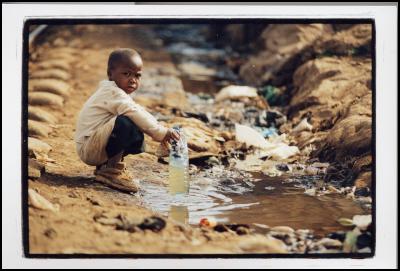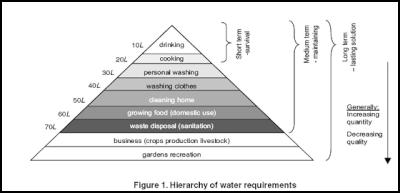World Water Day: How much water is enough?
How much water is enough?

Click to enlarge
A child collecting drinking water from a water source in a slum in Kenya. Source: Phill Prendeville
MEDIA RELEASE 22
March 2007
Opinion Piece
How much water is enough?
As the United Nations celebrates World Water
Day today we consider how much water is enough to
survive.
As New Zealanders we don’t generally have to worry too much about our water supply. While we have endured water shortages at one time or another, New Zealand, unlike many other countries globally, is not faced with ongoing problems of water scarcity that hinders our ability to survive or make a living.
However, worldwide more than 1 billion people live in areas where water is in short supply and more than one-third of the world's population has no access to sanitation facilities because of this. Unfortunately, this water crisis is predicted to worsen.
In the last century, global water consumption rose six-fold, more than double the rate of population growth. As freshwater resources continue to disappear the World Bank estimates that by 2035 there will be 3 billion people with no access to any safe water, period. Most of these people will be living in developing countries which lack the infrastructure and support systems of industrialised nations to deal with this impending crisis.
Minimum international guidelines require that each person has access to at least 20 litres per day. On average each of us, here in New Zealand, uses between 160 and 330 litres of water per day for domestic use. Compare this with sub-Saharan Africa where each person uses on average 10 – 20 litres per day.
For most of sub-Saharan Africa, the amount of water used is limited to what can be carried. In these countries, it is common for water collectors, usually women and girls, to walk for several hours every day to fetch water.
The idea of having to walk for hours carrying heavy pots of water would be unimaginable to most New Zealanders. Despite this effort, the water collected often barely meets household needs and is unsafe resulting in regular bouts of illness.
In developing countries, about 80 per cent of illnesses are linked to poor water and sanitation conditions. Two million children die every year as a result of preventable water-borne diseases, the equivalent of 5,500 children dying every day.
Time spent collecting water and coping with illness could be better spent earning an income or receiving an education, activities that reduce poverty. The results of improving access to water can be seen recently in the Kenyan community of Emali where ChildFund has built a borehole and two shallow wells close to villages as part of an ongoing project to provide water to the region.
In Emali, Maasai women used to spend six hours or
more collecting water every day.
Their typical day
involved rising at 3am to prepare their children for school,
milking the cattle and doing household chores before leaving
the house at around 9 am to walk to the closest water source
to collect water. The women walked during the heat of the
day, with little or no food, returning at the earliest
around 3 pm. The women could at most carry only one 20-litre
jerry can severely restricting how much water they brought
back for the family.
The newly constructed wells have reduced the time to collect water to as little as 30 minutes making a dramatic impact on the lives of the women. With a source of readily available clean water and extra time these women are now growing additional food and running micro-enterprise projects to earn an income for their families.
Relatively low cost water projects like this result in immediate benefits to communities, giving people the chance to leave behind a life of mere subsistence and move towards economic prosperity.
One of the Millennium Development Goal agreed to in 2001 at the Millennium Development Summit and ratified by 189 countries, including New Zealand, set a target of reducing by half the number of people without access to safe drinking water and sanitation by 2015. To meet this target would cost around US$8 billion annually or about the same amount of money spent monthly by the United States on the Iraq war.
The return on this investment would be a substantial reduction in world poverty and a growth in developing nations’ economies. While a lack of safe water and sanitation undermines sustainable development, improved water and sanitation increases productivity by improving people’s ability to earn an income, ensuring food supplies and relieving them of the burden of ill health.
As New Zealanders, we rarely consider the water we use, so it is humbling to think that something we take for granted is so precious, and literally the difference between life and death, to those who have so little of it.
For more information about ChildFund call 0800 223 111 or go to www.childfund.org.nz
How much water
do we use?
Litres of water/ Per person per day for
domestic use
New Zealand 160 – 330
Europe/North
America 200 - 600
Sub-Saharan Africa 10-20
Minimum
international guidelines 20
ENDS

Click to enlarge
Table: World Health Organisation hierarchy of water requirements.


 Gordon Campbell: On Marketing The Military Threat Posed By China
Gordon Campbell: On Marketing The Military Threat Posed By China Community Housing Aotearoa: Ngā Wharerau o Aotearoa Says New Partnership Model Helping Ensure Right To A Decent Home Is Realised
Community Housing Aotearoa: Ngā Wharerau o Aotearoa Says New Partnership Model Helping Ensure Right To A Decent Home Is Realised Greenpeace Aotearoa: Babies At Risk Due To Nitrate-Contaminated Drinking Water In Ashburton District
Greenpeace Aotearoa: Babies At Risk Due To Nitrate-Contaminated Drinking Water In Ashburton District Driving Change Network: Response To Government’s Proposed Driver Licensing Changes
Driving Change Network: Response To Government’s Proposed Driver Licensing Changes The New Zealand Remembrance Army: Victoria Cross And Hardham Cup Come Together For First Time In Over 100-years
The New Zealand Remembrance Army: Victoria Cross And Hardham Cup Come Together For First Time In Over 100-years RNZ Online: How The World Reacted To The Demise Of The Treaty Principles Bill
RNZ Online: How The World Reacted To The Demise Of The Treaty Principles Bill Te Matapihi: Response To Govt’s New Strategic Housing Partnerships: Progress, But Equity Gaps Remain
Te Matapihi: Response To Govt’s New Strategic Housing Partnerships: Progress, But Equity Gaps Remain


